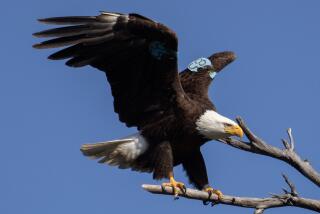BREEDING BIRDS: HOODED ORIOLE : HOODED ORIOLE (Icterus cucullatus)
- Share via
Description: Bills are long and slightly curved. The breeding male is orange-yellow with a black upper back, wings and tail. A black patch extends over throat area, and there are two whitish bars on the wings. Female lacks black throat and back.
Habitat: Riparian woodland, palm groves, arid scrub, deciduous woodland, around human habitation.
Diet: Insects, nectar, fruit.
Displays: In courtship, on elevated perch, male performs series of exaggerated bows toward female as he approaches, then hops around her singing softly with head pointed skyward; female may respond with similar posture.
Nest: Hanging nest, suspended from twigs or woven through overhanging leaves of palm. When located in palm trees, as they often are in Orange County suburban neighborhoods, nest often rests on palm fronds rather than hanging freely.
Eggs: Dull white marked with browns, purples and grays; slightly less than 1 inch long.
Natural history notes: Hooded orioles are partial to palms for nesting, and they are especially common in suburban areas where palms and exotic shrubs are extensively planted. Brown-headed cowbird chicks are sometimes found in oriole broods. The cowbird is a nest parasite that lays its eggs in nests belonging to other species and whose young are raised by surrogate parents.
Breeding bird atlas: To report bird breeding activity in your neighborhood, or to get information on the breeding bird atlas (now in its fifth and final year), call Sea and Sage Audubon Society members Sylvia Gallagher, (714) 962-8990, or Nancy Kenyon, (714) 786-3160.
Sources: Sea and Sage Audubon Society; “The Birder’s Handbook,” Ehrlich, Dobkin and Wheye, Fireside Books (1988); “Field Guide to the Birds of North America,” National Geographic Society (1987); “Birds of Southern California: Status and Distribution,” Garrett and Dunn, Los Angeles Audubon Society (1981).






